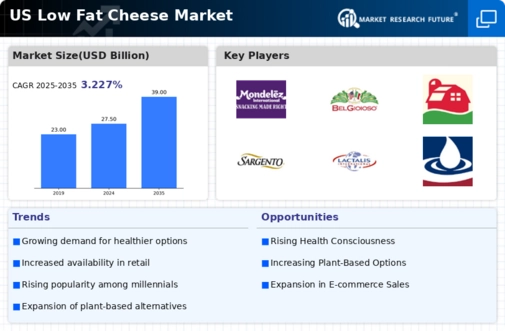Rising Health Awareness
The increasing awareness of health and wellness among consumers is a pivotal driver for the low fat-cheese market. As individuals become more conscious of their dietary choices, the demand for healthier alternatives, such as low fat cheese, has surged. According to recent data, approximately 60% of consumers actively seek low fat options in their dairy purchases. This trend is particularly pronounced among millennials and Gen Z, who prioritize nutritional content and ingredient transparency. The low fat-cheese market is thus experiencing a shift, with brands adapting their offerings to cater to this health-centric consumer base. This heightened focus on health is likely to continue influencing purchasing decisions, as consumers increasingly associate low fat cheese with a balanced diet and healthier lifestyle.
Growing Popularity of Snacking
The trend towards snacking is reshaping the low fat-cheese market, as consumers increasingly seek convenient and healthier snack options. With busy lifestyles, many individuals are opting for quick, nutritious snacks rather than traditional meals. Low fat cheese, often perceived as a healthy snack alternative, is gaining traction in this context. Recent surveys indicate that nearly 40% of consumers prefer snacking on cheese products, particularly those that are low in fat. This shift in eating habits presents a lucrative opportunity for the low fat-cheese market to expand its product lines and marketing strategies to appeal to snackers looking for healthier choices.
Innovative Marketing Strategies
The low fat-cheese market is experiencing a transformation driven by innovative marketing strategies that resonate with health-conscious consumers. Brands are increasingly leveraging social media and influencer partnerships to promote their low fat cheese products, highlighting their health benefits and versatility. This approach appears to be effective, as engagement rates on health-related food content have risen significantly. Furthermore, targeted advertising campaigns that emphasize the nutritional advantages of low fat cheese are likely to attract a wider audience. The low fat-cheese market is thus adapting to the digital landscape, utilizing modern marketing techniques to enhance brand visibility and consumer engagement.
Increased Demand for Dairy Alternatives
The low fat-cheese market is witnessing a notable rise in demand for dairy alternatives, driven by a growing number of consumers adopting plant-based diets. This shift is not merely a trend but appears to be a fundamental change in dietary preferences. Data indicates that the market for dairy alternatives is projected to grow at a CAGR of 10% over the next five years. As consumers seek options that align with their ethical and health values, the low fat-cheese market is responding by introducing innovative products that cater to both traditional and plant-based diets. This diversification is essential for brands aiming to capture a broader audience and meet the evolving needs of health-conscious consumers.
Regulatory Support for Healthier Products
Government initiatives aimed at promoting healthier eating habits are significantly impacting the low fat-cheese market. Policies encouraging reduced fat and sugar content in food products are fostering an environment conducive to the growth of low fat cheese. For instance, the USDA has implemented guidelines that advocate for lower fat dairy options in school meal programs. This regulatory support not only enhances the visibility of low fat cheese but also encourages manufacturers to innovate and reformulate their products. The low fat-cheese market is thus positioned to benefit from these initiatives, as they align with public health goals and consumer demand for healthier food choices.
























Leave a Comment